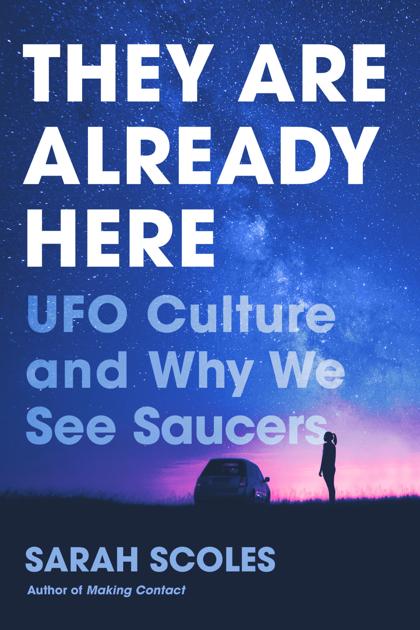Three books examine what UFOs can tell us about life on Earth

UFO sightings happen in clusters. The same is true of books about UFOs. While clusters of UFO sightings are called “flaps,” there is no similar term for clusters of UFO books. I propose calling them a “Sagan” (despite the risk of implying that there are billions and billions of them).
Sarah Scoles’s “They Are Already Here: UFO Culture and Why We See Saucers,” David J. Halperin’s “Intimate Alien: The Hidden Story of the UFO” and Keith Cooper’s “The Contact Paradox: Challenging Our Assumptions in the Search for Extraterrestrial Intelligence” take a similar approach to the question of UFOs. Maybe we have been visited, maybe not (probably not), but regardless, what does it mean that so many of us have these experiences and beliefs?
They Are Already Here: UFO Culture and Why We See Saucers,” by Sarah Scoles
Scoles treats UFOlogy sincerely as a religion replete with congregations and sects, holy sites, sacred texts, and theological debates.
A lapsed Mormon, Scoles sees parallels between her religion and UFOlogy, both derived from American culture, not Middle Eastern antiquity. “They Are Already Here” presents the reader with an exploration of this new religion — its leaders, schisms and followers — while reading like a travel narrative. Scoles, often accompanied by her sister, visits Area 51, Roswell, UFO conventions and offbeat roadside attractions. She does not get into Area 51 or provide insider information about government coverups or alien autopsies. Rather, she camps in the vicinity, takes sketchy private tours, gets approached by park rangers and federal agents, gets scared by trucks rumbling by during the night, and chats with lots of people. Her interest is not in supporting or debunking claims, but in understanding the beliefs and the believers.
“The Contact Paradox: Challenging Our Assumptions in the Search For Extraterrestrial Intelligence,” by Keith Cooper
Where Scoles is always careful to distance herself from the UFOlogist congregants, Halperin admits to being a lifelong member. Growing up a smart but alienated child with a terminally ill mother in the early 1960s, he buried himself in the world of ETs, full of mystery. He became a professor of religious studies, researching Jewish mysticism — and realizing that his youthful fascination and professional studies were intertwined.
Halperin considers extraterrestrials to be a myth. But where we commonly use that word to mean a false story, he takes it as a technical term from a Jungian perspective. Psychoanalyst Carl Jung held that there is a universally shared portion of the unconscious mind that connects all people and shows itself in myths: deep-seated mental constructs used to make sense of the world.
UFOs, Halperin argues, are such myths. They do not come from space but from the human mind. This does not make them false, he contends; quite the opposite. What they expose about us individually and collectively is, in fact, a much deeper truth.
The first promoted story of alien abduction involved Barney and Betty Hill, a mixed-race couple, in 1961. Shortly after an uncomfortable experience with racist ruffians, the Hills claimed, they were abducted by a UFO in Lincoln, N.H. Halperin examines the transcripts of the Hills under hypnosis, noting language that uncannily connects to the experiences of enslaved Africans. Could such experiences be buried in the subconscious of those whose ancestors lived through them? Do our UFO experiences allow us to direct away from Earth that which we need to unearth within ourselves?
“Intimate Alien: The Hidden Story of the UFO,” by David Halperin
In “The Contact Paradox,” Cooper approaches the question from the opposite direction. Where Scoles and Halperin look at past claims of extraterrestrial interactions, Cooper looks at those who are seeking them using our best current theories and tools. The editor of Astronomy Now and Astrobiology Magazine, Cooper examines the assumptions and inferences made by the professional researchers engaged in the SETI (Search for Extraterrestrial Intelligence) project. The presuppositions of scientists seeking evidence of life beyond Earth tell us a lot about what we consider the essence of the life-forms doing the looking.
Searching for evidence of extraterrestrial life is trickier than it would seem. Just listen for a signal, we say. But what kind of signal? How do we know if it is a signal? What would be used to send the signal? We think automatically of large radio telescopes, their concave dishes pointing skyward. But what frequency should we monitor looking for non-random noise?
Scientists have reasoned that you often find different kinds of life around a water hole, so we should look at the telescopic water hole. Chemical elements emit telltale frequencies when excited. Hydrogen peaks at 1420 MHz and a molecule of hydrogen and oxygen at 1666 MHz. Since the two combine to create water, the radio telescopes keep track of what they hear between those two frequencies — the water hole. It would make sense if there was someone out there like us trying to contact us.
But would the life out there be like us? What other kinds of intelligences could there be? Cooper points out that there are other sorts of intelligences right here on Earth: dolphins, octopi, elephants. We need to understand how they think to broaden our sense of what we might be looking for. The great virtue of Cooper’s discussion is that it gives readers a picture of living science. Too often, science is presented as fixed, solved, completed. Cooper shows us scientists disagreeing, presenting and supporting alternative theories, and gives clear discussions of the differing views, letting the science live.
So, is there intelligent life beyond Earth? This Sagan of books will not answer that question. But what these three books will do is make you think much more deeply about what such questions mean. If you look into a telescope backward, it becomes a microscope. Looking from both ends can be the source of fascinating insights.


